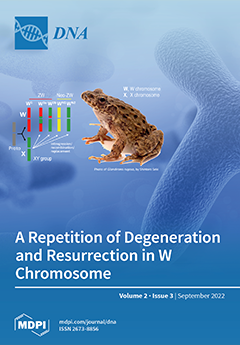The Y or W sex chromosome of a heteromorphic pair is usually heterochromatinised and degenerated. However, whether chromosome degeneration constantly proceeds toward an extreme end is not fully understood. Here, we present a case of intermittent evolution of W chromosomes caused by interpopulation
[...] Read more.
The Y or W sex chromosome of a heteromorphic pair is usually heterochromatinised and degenerated. However, whether chromosome degeneration constantly proceeds toward an extreme end is not fully understood. Here, we present a case of intermittent evolution of W chromosomes caused by interpopulation hybridisation in the Japanese soil-frog,
Glandirana rugosa. This species includes two heteromorphic sex chromosome systems, which are separated into geographic populations, namely the XY and ZW groups. In this study, to uncover the evolutionary mechanisms of the heterogeneous W chromosomes, we genetically investigated the geographic differentiation of the ZW populations along with the closely located XY populations. Analysis of mitochondrial
cytochrome b sequences detected three distinct clades, named ZW1, ZW2, and ZW3. High throughput analyses of nuclear genomic DNA showed that autosomal alleles of XY populations were deeply introgressed into the ZW3 sub-group. Based on the genotypes of sex-linked single nucleotide polymorphisms, W-borne
androgen receptor gene expression, and WW developmental mortality, we concluded that the X chromosomes were recycled to W chromosomes. Upon inclusion of two cases from another group, Neo-ZW, we observed that the X chromosomes were recycled independently at least four times to the new W chromosomes: a repetition of degeneration and resurrection.
Full article



